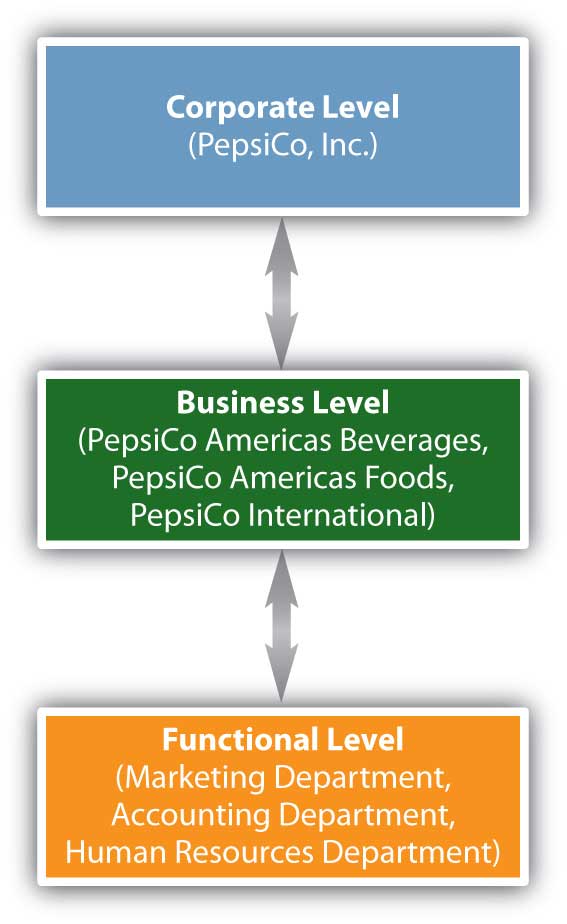Chapter 2: Strategic Planning
2.4 Where Strategic Planning Occurs within Firms
Learning Objectives
- Identify the different levels at which strategic planning may occur within firms.
- Understand how strategic planning that occurs at multiple levels in an organization helps a company achieve its overall corporate objectives.
As previously mentioned, strategic planning is a long-term process that helps an organization allocate its resources to take advantage of different opportunities. In addition to marketing plans, strategic planning may occur at different levels within an organization. For example, in large organizations, top executives will develop strategic plans for the corporation as a whole. These are corporate-level plans. In addition, many large firms have different divisions, or businesses, called strategic business units. A strategic business unit (SBU) is a business or product line within an organization that has its own competitors, customers, and profit center for accounting purposes. A firm’s SBUs may also have their own mission statement (purpose) and will generally develop strategic plans for themselves. These are called business-level plans. The different departments, or functions (accounting, finance, marketing, and so forth) within a company or SBU, might also develop strategic plans. For example, a company may develop a marketing plan or a financial plan, which are functional-level plans.
Figure 2.13 “Strategic Planning Levels in an Organization” shows an example of different strategic planning levels that can exist within an organization’s structure. The number of levels can vary, depending on the size and structure of an organization. Not every organization will have every level or have every type of plan. An overview of the marketing (or functional) plan is presented briefly at the end of this chapter but will be discussed in detail in Chapter 16 “The Marketing Plan” so you can see how the information discussed throughout the text may be used in developing a marketing plan.

The strategies and actions implemented at the functional (department) level must be consistent with and help an organization achieve its objectives at both the business and corporate levels and vice versa. The SBUs at the business level must also be consistent with and help an organization achieve its corporate-level objectives. For example, if a company wants to increase its profits at the corporate level and owns multiple business units, each unit might develop strategic plans to increase its own profits and thereby the firm’s profits as a whole. At the functional level, a firm’s marketing department might develop strategic plans to increase sales and the market share of the firm’s most profitable products, which will increase profits at the business level and help the corporation’s profitability. Both business level and functional plans should help the firm increase its profits so that the company’s corporate-level strategic objectives can be met.

For example, take PepsiCo, which has committed itself to achieve business and financial success while leaving a positive imprint on society. PepsiCo identifies its three divisions (business units) as (1) PepsiCo Americas Beverages, which is responsible for products such as Pepsi soft drinks, Aquafina waters, Tropicana juices, and Gatorade products; (2) PepsiCo Americas Foods, which is responsible for Frito-Lay and Quaker Oats products; and (3) PepsiCo International, which consists of PepsiCo’s businesses in Asia, Africa, Europe, and Australia2. To support PepsiCo’s overall corporate strategy, all three business units must develop strategic plans to profitably produce offerings while demonstrating that they are committed to society and the environment.

At the functional (marketing) level, to increase PepsiCo’s profits, employees responsible for different products or product categories such as beverages or foods might focus on developing healthier products and making their packaging more environmentally friendly so the company captures more market share. For example, the new Aquafina bottle uses less plastic and has a smaller label, which helps the environment by reducing the amount of waste.
Let’s see whether you can assign the correct strategic planning level to its position within an organization!
Organizations can utilize multiple methods and strategies at different levels in the corporation to accomplish their various goals just as you may use different strategies to accomplish your goals. However, the basic components of the strategic planning process are the same at each of the different levels. Next, we’ll take a closer look at the components of the strategic planning process.
Key Takeaway
Strategic planning can occur at different levels (corporate, business, and functional) in an organization. The number of levels may vary. However, if a company has multiple planning levels, the plans must be consistent, and all must help achieve the overall goals of the corporation.
Review Questions
- What different levels of planning can organizations utilize?
- Give an example and explain how a corporation that wants to help protect the environment can do so at its corporate, business, and functional levels.
1Goodyear Tire & Rubber Company, http://goodyear.com [new tab].
2PepsiCo, Inc., “The PepsiCo Family,” https://web.archive.org/web/20091228143833/http://www.pepsico.com/Company/The-Pepsico-Family.html (accessed July 20, 2021).

